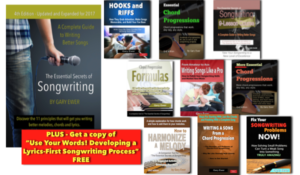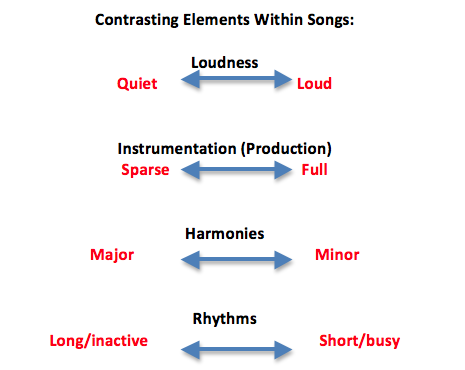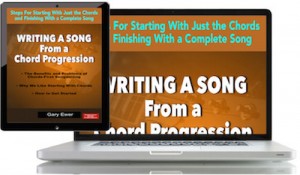Most songs make use of contrasting characteristics as a way of keeping listeners interested. You might get a song with a verse that’s quiet, at least in comparison to the chorus. “Smells Like Teen Sprit” (Nirvana) is a good example, and practically any power ballad.
 If you’re looking for one set of eBooks that will cover everything you need to know about writing songs –creating melodies, lyrics, chord progressions, and more — “The Essential Secrets of Songwriting” 10-eBook Deluxe Bundle is what you’re looking for. It always comes with a SPECIAL DEAL.
If you’re looking for one set of eBooks that will cover everything you need to know about writing songs –creating melodies, lyrics, chord progressions, and more — “The Essential Secrets of Songwriting” 10-eBook Deluxe Bundle is what you’re looking for. It always comes with a SPECIAL DEAL.
And it’s more than just the general loudness that’s contrasted. Many songs will feature melodies in the singer’s low range, then by contrast the melody will move higher. Full versus sparse production, major versus minor… these are all ways that contrast is used.

Most of the time listeners are unaware of how important it is to use contrast in a song. It’s more a situation where they’re likely to hear the musical excitement that comes from contrast more so than to understand and realize the cause of that excitement.
While it’s true that not every song will juxtapose every possible opposite characteristic (some songs are quiet from beginning to end, for example), it’s safe to say that a song with little or no contrasting elements will leave the audience feeling like there’s nothing to listen to. A bit like trying to get interested in a white wall.
In effect, we’re talking about opposites. Good music needs to display opposite effects. Sometimes you might near those opposites in relatively close proximity to each other, like a loud phrase followed immediately by a quiet one. And sometimes you need to wait for the next section of a song, such as hearing a minor key verse followed by a major key chorus.
In addition to the characteristics shown in the graphic above, there are other ones you might want to consider:
- GENERAL MUSICAL COMPLEXITY. Prog rock gives us the best examples of this, and I think “Gates of Delirium“, from The 1974 Yes album “Relayer” is a good example. As you listen, you’ll notice that you get very complex harmonies, rhythms and musical phrasing, and then suddenly everything seems to simplify, and you get, by contrast, something that’s almost hook-like and easy to sing along with. That moving back and forth from complexity to simplicity is a mainstay of the progressive rock era, but also quite usable in more accessible genres.
- USE OF VOCAL HARMONIES. More often than not, a producer will encourage the use of vocal harmonies as a way of increasing musical energy and excitement, and it’s going to have its best effect if it’s contrasted by sections where there are no vocal harmonies.
- TIME SIGNATURES. Some songwriters find anything other than standard 4/4 time difficult to work with, but if you’ve got some experience with changing up time signatures, try complex ones for a verse, and follow it up with a simpler 4/4 meter for the chorus. In pop songwriting, even alternating between a 3/4 verse and a 4/4 chorus is all that’s necessary to give the impression of the opposite qualities of complexity and simplicity, as we hear in The Beatles’ “Lucy in the Sky With Diamonds.”
- OCTAVE DISPLACEMENT OF MELODY. This is a good technique to explore for songs that use the same melody for verse and chorus. Moving the melody an octave higher for the chorus means that you’re using the same tune, but now you get the benefit of a complete change in vocal quality. Tom Petty’s “Free Fallin’” shows the benefit of this technique.
Don’t feel that every possible quality or characteristic of a song needs to have an opposite somewhere else within the song. It’s probably better to say that songs with no opposite qualities run the risk of sounding boring or uneventful.
It’s more a case of exploring opposites if you determine that what you’ve written sounds dull, with no apparent cause. When that happens, it’s time to make a list of all the possible contrasts your song could be demonstrating.
 Written by Gary Ewer. Follow Gary on Twitter
Written by Gary Ewer. Follow Gary on Twitter
 If you like starting songs by working out the chord progression first, you will love “Writing a Song From a Chord Progression.” It’s part of the 10-eBook “Essential Secrets of Songwriting” Bundle.
If you like starting songs by working out the chord progression first, you will love “Writing a Song From a Chord Progression.” It’s part of the 10-eBook “Essential Secrets of Songwriting” Bundle.










